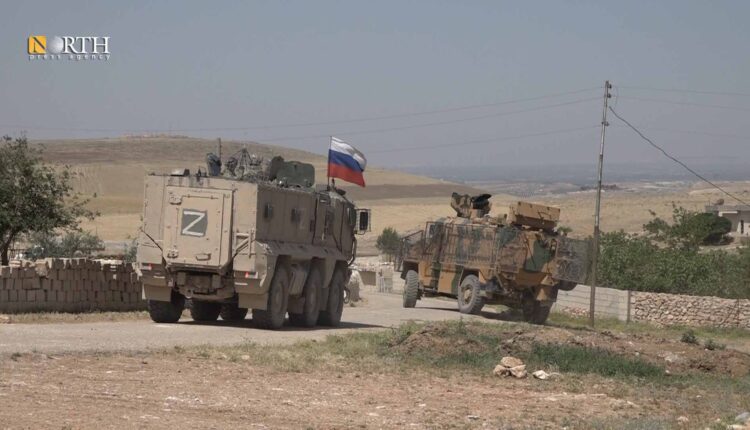
KOBANI, Syria (North Press) – Residents of Kobani, a city northern Syria, say that conducting Russian-Turkish joint patrols did not fulfill their objectives to preserve safety and stability in the region.
The joint patrols did not bind Turkey to refrain from shelling inhabited villages though Russia and Turkey had signed a ceasefire agreement.
Following the Turkish “Peace Spring” military operation in October 2019, which resulted in the occupation of the two cities of Tel Abyad, north of Raqqa, and Sere Kaniye (Ras al-Ain), in north of Hasakah, Turkey signed two ceasefire agreements, one with Russia and the other with the US.
The agreements stipulate halt of all hostilities there and the withdrawal of the SDF 30 km in depth away from the Turkish border in addition to conducting Turkish-Russian joint patrols in order to monitor the implementation of the agreements.
Since then Russia and Turkey have conducted 100 joint patrols on a weekly basis in both the eastern and western countryside of Kobani.
The patrols are mostly intercepted by the residents of the region who throw them with stones, expressing their rejection.
On Wednesday, a woman and a child were wounded during bombardment by the Turkish forces and their affiliated SNA factions on the village of Shisha, southeast of Kobani, north Syria.
The shelling took place two days after conducting the 100th Russian-Turkish joint patrol in the western countryside of Kobani.

On April 22, two civilians were wounded and a shop and a house were damaged due to Turkish shelling of the city center of Kobani city, north Syria.
Farhan Sheikho, a resident of the western countryside of Kobani, said, “Though they conduct these joint patrols periodically, so far the region is not safe or stabilized .”
“Rather violations increase, as the guarantor does not assume its responsibilities,” Sheikho added.
On January 8, Turkish shelling mainly hit the countryside of Kobani in the villages of Qaramogh, where six people from one family were injured, including the four-year-old child Abdo Hanifi whose leg was amputated.
Ten days after the shelling, Russian and Turkey conducted the 85th joint patrol, which was intercepted by the residents of the region.
Lack of stabilization
Sheikho further explained that the Turkish bombardment and shells spread panic and horror among the residents since the bombardment kills and wounded civilians.
Residents of the region say that they witness destabilization because Turkey’s main objective is to target the civilians and displace them aiming at fulfilling its aspiration to cut more Syrian parts in the Syrian north.
They question the use and importance of these patrols, especially that they cannot curb Turkey from targeting Kobani and its countryside.
On May 12, the Turkish forces targeted villages in the western countryside of Kobani, as well as military headquarters of the Syrian government forces.
Dozens of shells fell on the villages of Ashma, Kharab Atto, Ziyara, Zor Maghar, Jarqali Fawqani and Bayada in the western countryside of Kobani.
The shelling targeted the government forces’ posts in the villages of Zor Maghar and Ashma, causing material damage to the government headquarters and caused fires to surrounding farms.
Mahmmud Kobani, a leader in Kobani Military Council, said that they maintain a constant communication with the Russian forces, “but the Russia response is disappointing and conflicts with the agreement,” in a reference to the ceasefire agreement signed in 2019.
The military leader added that the ongoing Turkish violations of the agreement indicate that the guarantor [here it is Russia] does not assume to its obligations.
The residents stress that the international guarantors Russia and the US as well as human rights committees should assume their responsibilities in binding Turkey to comply with the terms of the ceasefire agreement.

Inactive guarantor
On June 1, the Turkish forces targeted vicinity of a cement factory in the southeastern countryside of Kobani.
Muhammad Sheikho, a resident of the western countryside of Kobani, expressed his fears of the persistent Turkish shelling of the region in light of the successive Turkish remarks of a new invasion of Kobani.
On May 23, Turkish President Recep Tayyip Erdogan said, “We will soon take new steps regarding the incomplete portions of the project we started on the 30-km deep safe zone we established along our southern border.”
The Turkish safe zone is an area 30-35 km (19-22 miles) deep into Syrian territory that Turkey started establishing in 2019, claiming that it aims at housing Syrian refugees in an area along its border with Syria, as well as to keep it free from the Syrian Democratic Forces (SDF), which it regards as terrorists.
The residents expressed their anger over the joint patrols that Turkey and Russia claimed to implement aiming at protecting the residents and preserve their safety, but in reality they are pro form measures.
During the ongoing Turkish shelling of Kobani countryside, residents flee their houses to protect themselves.
Sheikho also holds Russian guarantor of the ceasefire agreement responsibility for the successive Turkish violations, calling on it to take firm stance and stop the Turkish bombardment against these areas.
